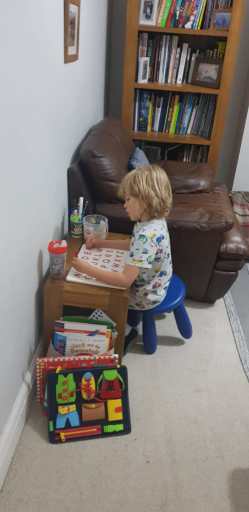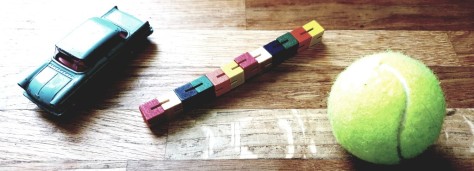Twelve little picture cards are placed sequentially down the wall. Each one in the green coloured section showing that they are still to happen.
I remember the process we went through to get to the full list of the day’s events. Initially I had placed them all on the wall and somehow expected Rhys to acknowledge the process – I was obviously delusional, or maybe just had a lot still to learn!
Three years ago we had mastered the first-then strategy. The use of two pictures to move Rhys between activities, communicating a clear sequence and managing the transition. Pictures became the basis of everything. I used them to communicate with him, reducing anxiety and avoiding meltdowns.
I would place little pictures onto a green card showing where we were going and what would happen next. Crouching down to Rhys’ eye level in carparks, shopping centres and play areas with my sequence of pictures got a number of stares from the passers by, but I didn’t see the on looking eyes, I saw my son and the need to do everything to communicate with him and avoid a meltdown due to confusion and frustration.

The miniature schedule worked extremely well, and I continued to use it in a portable fashion.
After a few months, I changed to a red and green card adding a few extra activities to the sequence. Hand-over-hand I helped Rhys move each activity card from the green section to the red section to signify its completion.
It didn’t take long for Rhys to master this second step.
Once comfortable, I implemented the final stage. I took the schedule card we had been using for a number of weeks and stuck it to the hallway wall. The perfect central location to communicate our plan. As the activities were completed, I would take Rhys to the wall for him to move the card to the red section.
He soon knew where to see his plan. Now consisting of over twelve activities per day.

As I finished making the dinner this evening, I spotted a mop of blonde hair walk up to the communication wall. The little hand reached for the dinner card and moved it across to the red, “All finished” he said. But he wasn’t finished, he kept going. Bath, pyjamas, brush teeth were moved across too, and then the hand tapped the last card, “Bedtime!” it said, and two little legs walked down the hallway and up the stairs.
Schedules can help communicate the events of the day, but they can do so much more, like communicating when your little one is done.
👕🍳🚗🛁🛏
Click here to get a step by step guide to schedules.










